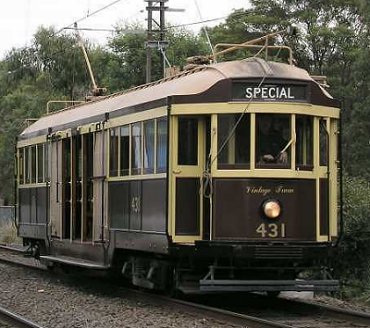Melbourne Tram Museum
- Follow Melbourne Tram Museum on Twitter
- Follow Melbourne Tram Museum on Facebook
- Follow Melbourne Tram Museum on Instagram
- Follow Melbourne Tram Museum on Pinterest
- Follow Melbourne Tram Museum on Tumblr
- Subscribe to Melbourne Tram Museum's RSS feed
- Email Melbourne Tram Museum
Melbourne & Metropolitan Tramways Board W1 Class No 431
No 431 is of interest as it represents the first major variation in the development of the standard Melbourne W class tram design. This was an attempt to replicate the passenger-carrying characteristics of the standard Melbourne cable tram set in an electric tramcar design, through the provision of the open drop centre and two end saloons, matching the open cable tram grip car and the closed cable tram salon trailer car.
 M&MTB No 431 at Montague Street, South Melbourne, June 2004.
M&MTB No 431 at Montague Street, South Melbourne, June 2004. - Photograph courtesy Mal Rowe.
The standard W class tramcar, as exemplified by No 380, was not entirely satisfactory, so one of the W class tramcars was completed in 1925 with an open drop centre and longitudinal flip-over seats. This design showed some promise, so another 29 cars were built by the Melbourne & Metropolitan Tramways Board (M&MTB) to the same design between 1925 and 1928, all 30 cars being classified as W1 class trams. W1 431 entered service on 13 June 1927, and it spent its life at Coburg, Kew, Preston and South Melbourne Depots.
These cars were built as part of the program to convert Melbourne’s cable tram lines to electric traction and massively expand the Melbourne tramway system during the 1920s. Unfortunately, this program was brought to a halt by the onset of the Great Depression.
While the W1 class successfully met the requirement for rapid loading and unloading of passengers, in Melbourne’s inclement weather the canvas blinds were not that successful in keeping out the rain. Public attitudes were changing, and what had seemed acceptable on the old fashioned cable trams no longer offered enough comfort for passengers on the new electric trams. As a result 26 W1 cars – including No 431 – were converted during 1936-7 to the W2 class design. The remaining four cars were converted in 1938 to the SW2 class design with air-operated sliding doors. Some of the long drop centre seats were recycled for use in the lunchroom at South Melbourne depot.
Technically these trams were bogie drop-centre combination tramcars, a design type which was basically restricted to Australia and New Zealand. Mechanically simple and robust, examples of this basic design were in operation for over sixty years in the streets of Melbourne.
In May 1988 No 431 was reconverted back to its original form as a W1 class tram, using two of the original drop-centre seats recovered from the lunchroom at South Melbourne Depot. It was then used from time to time on a range of tourist services and special charters, including a wedding charter for the author on 14 April 1990.
No 431 is now an exhibit in the collection of the Melbourne Tram Museum. It is owned by VicTrack on behalf of the Government and people of Victoria.
Technical details
| Motors: | 4 x 40hp (MV 101) |
| Controller: | GE K35JJ |
| Truck: | M&MTB No 1 |
| Passengers: | 52 (seated), 93 (standing) |
| Weight: | 16.8 tons |
| Length: | 48 feet 0 inches |
| Width: | 7 feet 6 inches |
Bibliography
Cross, N., Budd, D., and Wilson, R. (1993) Destination City (Fifth Edition), Transit Australia Publishing
Cross, N., Henderson, R. and Kings, K. (1981) Destination City (Fourth Edition), Australian Electric Traction Association
Jones, R. (2008) Fares Please! An economic history of the Melbourne & Metropolitan Tramways Board, Melbourne Tram Museum